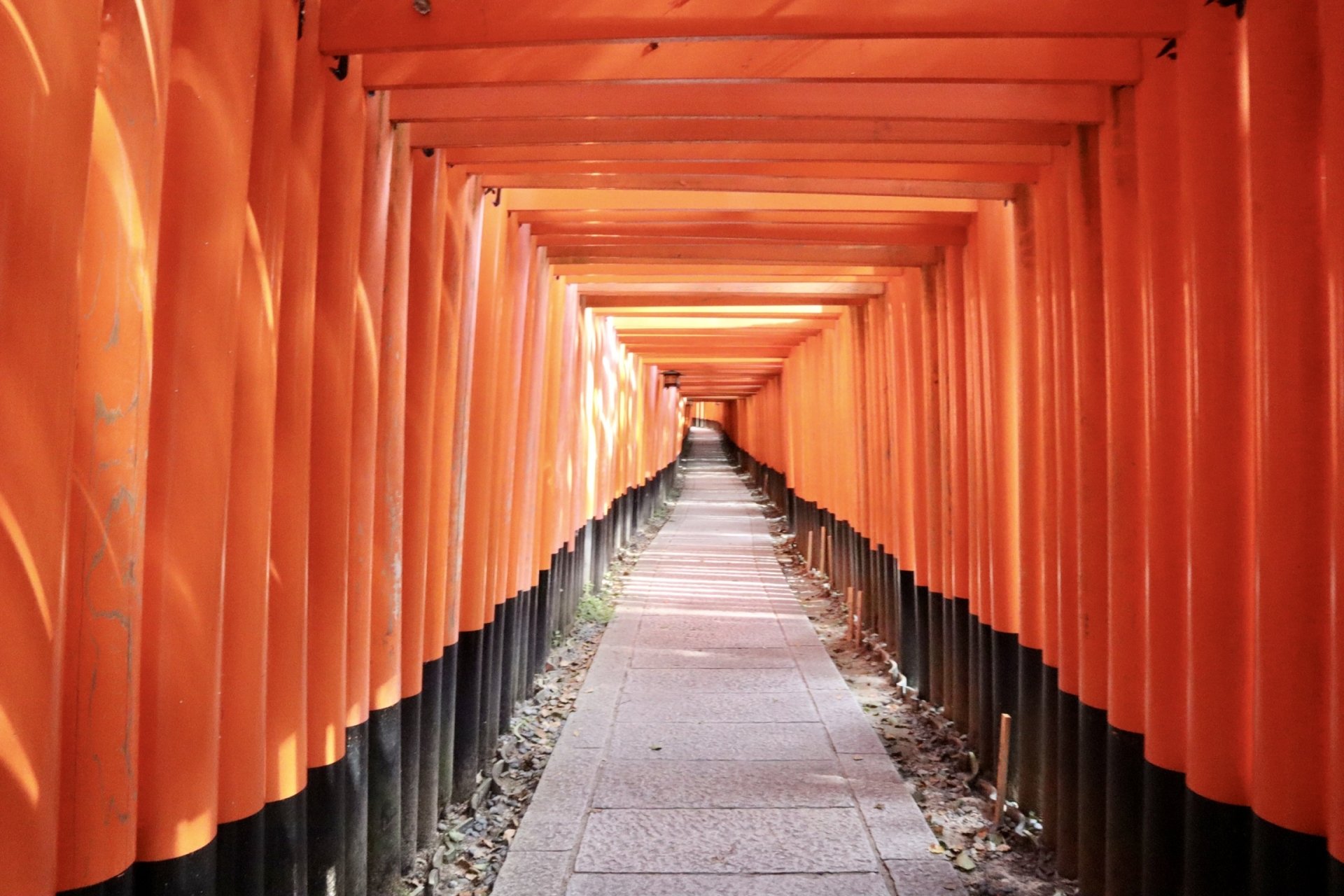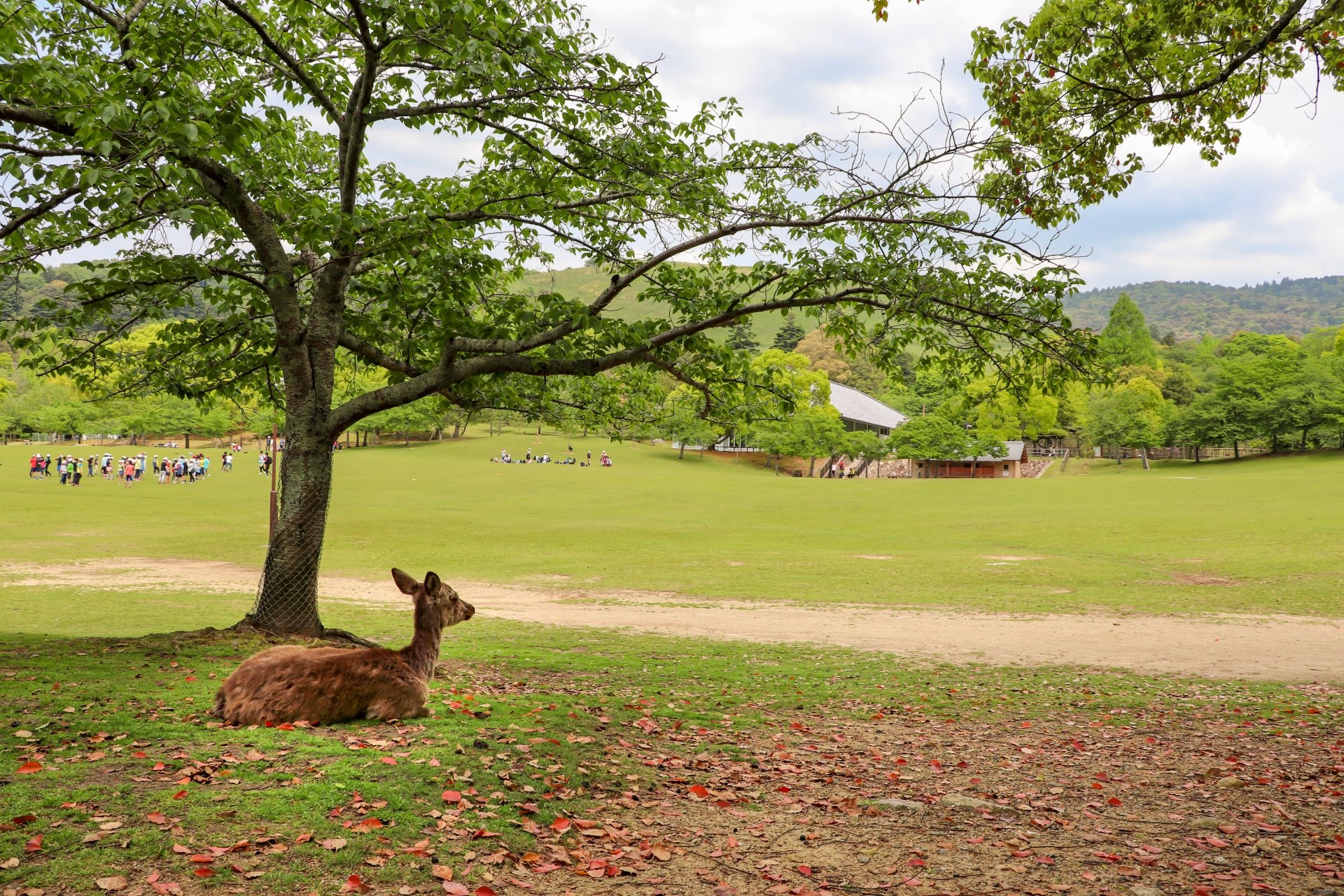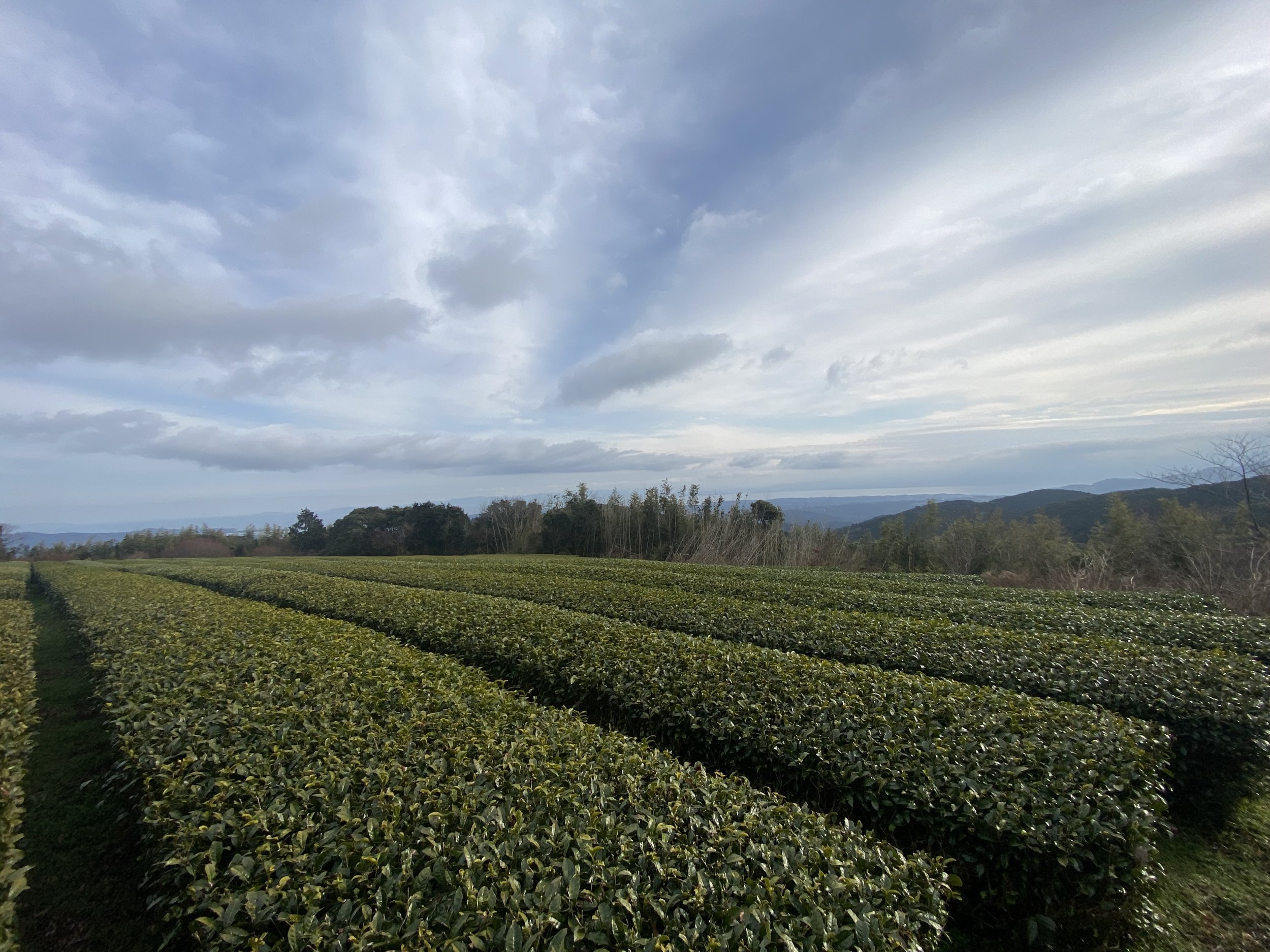HEART OF JAPAN
IMMERSIVE 8-DAY JAPAN ITINERARY
Trip Style: Explore
tEMPLES, HOTSPRINGS, NATURE AND CULTURE IN KYOTO, NARA, BEPPU AND OSAKA
Trip Highlights
Ferry to Beppu and soak in its hot springs
Visit ancient shrines & temples in Kyoto, Nara & Osaka
Visit a Japanese tea farm & enjoy a traditional tea tasting
Experience a Buddhist temple stay & Goma fire ritual with local monks
Indulge in seasonal cuisine & regional specialties








































Do you want to experience Japan in a uniquely culture-centered way? This 8-day Japan itinerary takes you into the heart of Japan with a focus on culture, cuisine and spiritual traditions. Starting in Kyoto, see the iconic red torii gates of the Fushimi Inari shrine and wander the cobblestone streets where Kodaiji Temple and Yasaka Shrine hearken historical eras. Go deeper into the Arashiyama and Sagano areas with a visit to 8,000 Buddhist statues, visit a 500-year old matcha tea house and stroll through a hidden bamboo. Continue by ferry to the famed hot spring town of Beppu where you’ll learn to cook a special onsen meal before resting in your traditional ryokan accommodations. Enjoy a farm day where you’ll meet local characters preserving seasonal agricultural traditions and visit a tea farm and enjoy a tasting. Our journey will culminate with a Buddhist temple stay where you have the chance to participate in sunrise meditation and breakfast with the monks. Finally, we’ll visit make our way to Osaka for fantastic farewell in a city renowned for its cuisine.
Select Japan Custom Dates spring, summer or fall! Starting at $6995 per person. See all inclusions, itinerary details and complete pricing in the drop downs below.
-
STARTING AT $6995 per person
Fully planned & booked 8-day Japan itinerary
Blend of train and private transit
Minimum of 4 people
TRIP INCLUsions
-
7 nights total stay
5 nights boutique 3-star hotel (private room & bath, Western-style beds)
1 night ferry (private room & toilet)
1 night Buddhist temple stay (private room with Japanese tatami mats, share bathroom)
-
Airport to hotel arrival/departure logistical assistance (cost of transfer not included)
JR Rail Pass and IC Card for all internal transfers included in itinerary by train, bus and light rail
Overnight ferry Osaka → Beppu
Private vehicle for Day 5 farm visits
-
Kyoto guided tour with optional visits to Kiyomizu-dera Temple & Yasaka Shrine and Fushimi Inari Taisha (with option to do the 4-hour hike)
Guided visit & entry to Adashino Nenbutsuji and Gioji temples
Guided tour of Nara and admission to Todaiji Temple
Beppu hot springs visit with admission to Umi and Onishi Bozu
Onsen (hot springs) lunch experience in Kannawa
Local countryside lunch experience
Tea farm visit and traditional tea tasting
Buddhist temple experience with overnight stay and morning meditation
Visit and entry to Himeji Castle
-
Daily traditional Japanese breakfast + 4 dinners + 2 lunches
Assistance to find the best local spots + make reservations (often required) for ramen, soba, sushi, etc.
-
Local community partner visit + donation to their organization
Dedicated local Japanese guide
Traverse representative assisting you from booking to departure
-
Additional nights in Kyoto (front end), Osaka (back end), or Tokyo (either)
Day 2 Geisha performance in Kyoto
Food tours in Osaka (Day 8) and Tokyo (before/after the base trip)
Transportation assistance to/from Tokyo
-
International airfare
Airport transfer costs (assistance with arrangements provided)
Additional meals, excursions and activities not listed
Tips to your local guides, and drivers
Alcohol or other drinks, unless specified
Required travel insurance
TESTIMONIALS
DAILY ITINERARY
-
Since Japan is a long haul for many travelers, some may decide to come a night or two early. Though our guided services won’t be ready yet, we’re happy to assist with early arrivals into Kyoto! See FAQs below for the best way to arrive into Kyoto.
Arriving today allows you to do an early morning hike to Fushimi Inari. See the Day 1 description for specifics!
-
Arrive in Kyoto by early afternoon today. See the FAQs below for the best ways to arrive, depending on your flight choices and any pre-tour plans. Your guide will be waiting at your local hotel ready to introduce you to this ancient city.
If you arrive the night before, this morning is the perfect time to do an early morning hike up Fushimi Inari.
Early Arrival Optional Hike: We’ll take an early train to the Fushimi Inari Taisha, a shrine located on Mt. Inari with 1300 years of history. It is renowned for its seemingly endless path of vibrant orange Torii gates. Of which nearly 3000 remain. Dedicated to Inari, the deity of a good harvest and success in business, Fushimi Inari Taisha is the head of all of Japan's Inari shrines. The hike to the top takes about four hours round trip, where you can see stunning views of Kyoto along the way.
Afternoon optional excursions: Depending on arrival times today, we’ll have options to explore central Kyoto. One option is to visit Kiyomizu-dera, a temple famous for its large pillars of the main hall, and Yasaka shrine, one of Kyoto's most famous shrines founded over 1350 years ago. The shrine's main hall combines the honden (inner sanctuary) and haiden (offering hall) into a single building. In front of it stands a dance stage with hundreds of lanterns that get lit in the evenings. Each lantern bears the name of a local business in return for a donation.
This takes us near the old cobblestone streets of Ichinenzaka, Ninenzaka, and Sannenzaka, which have prospered since ancient times. These sloping streets are lined with historic Japanese-style buildings that typify Kyoto.
Evening group plans: Tonight we’ll enjoy a fantastic Welcome Dinner in the style of obanzai, which is a Kyoto home-style cuisine made with fresh, seasonal ingredients. A great introduction to Japanese cuisine beyond what you may already know!
Meals: D
-
After a traditional Japanese breakfast, you’ll take a short train ride to spend the day in the Arashiyama and Sagano areas. We’ll first visit the Adashino Nenbutsuji temple, renowned for its 8000 Buddhist statues and hidden bamboo forest. Emperors and aristocrats have enjoyed this scenery since time immemorial. We’ll then visit the Gioji temple with its captivating moss garden and where wildflowers bloom according to the season.
We’ll then have a special stop for matcha tea, which is unique and historic to the Kyoto region. The tea house you’ll visit is more than 500 years old, and they still make their rice cakes over a wood-fired stove. The matcha maker is a 15th generation master, truly a legacy.
After, at we’ll have views of Arashiyama Mountain: The Togetsu-kyo Bridge, which has been a landmark in Western Kyoto's Arashiyama District for over four hundred years. The area is abundant with seasonal beauty, with cherry blossoms in spring and autumn leaves in autumn.
In the afternoon, we’ll take the train back into Kyoto for a free evening for you to explore. Consider exploring some of Kyoto's most picturesque neighborhoods including Ichinenzaka, Ninenzaka, and Sannenzaka, and Hanamikoji Dori.
This is also a great day to visit Gion, one of Kyoto’s most scenic and historically preserved districts and perhaps catch a geisha performance. It is filled with shops, restaurants and ochaya (teahouses), where geiko (Kyoto dialect for geisha) and maiko (geiko apprentices) entertain. You’ll also see many traditional wooden machiya merchant houses.
Meals: B
Add-ons: Evening geisha performance (reservations required)
-
Today we’ll pack our overnight bags for our day’s adventures and evening ferry. If you do not want to take all your luggage with you, you’ll have the option to bring an overnight bag and send the rest of your luggage to meet you in Beppu.
We’ll start with an express train to Nara, historically Japan's first permanent capital. Our first site is the Todaiji Temple, originally founded during the Nara period (710-784). It has now been designated as one of the Historic Monuments of Ancient Nara by the UNESCO World Heritage Convention along with other culturally and historically significant items throughout the city. The Great Buddha statue found within is designated as a national treasure, and the world's largest wooden structure.
Nara city is also home to hundreds of deer, concentrated in Nara Park. Established in 1880, it is the location of many of Nara's main attractions including Todaiji, Kasuga Taisha, Kofukuji and the Nara National Museum. It is also home to hundreds of freely roaming deer. Considered the messengers of the gods, these deer have become a symbol of the city and have even been designated as a natural treasure. Deer crackers are for sale around the park, and some deer have learned to bow to visitors to ask to be fed.
In the afternoon, we’ll take a train to Osaka’s “Sunflower Terminal” and board an overnight ferry bound for Beppu, a city famous for its hot springs. You’ll have a comfortable private room on board (twin share or single, depending on how you book) complete with an en suite toilet and wash basin. We will enjoy dinner at the ferry restaurant.
Meals: B, D
-
Upon your arrival in Beppu, we’ll head to our hotel to drop off luggage before breakfast at a local café. Then we’ll head out to explore two of Beppu's “seven hells” or onsen, Japanese hot springs. The first, Umi Jigoku, meaning “Sea Hell,” is considered the most beautiful among the seven. The water's captivating cobalt blue color is a result of its naturally high iron sulfate levels, which is rare even amongst Japanese hot springs. As the water temperature goes as high as 208° F / 98°C, it is needless to say that you can't bathe here. However, visitors can savor eggs boiled in the hot spring water, as well as puddings and various sweet buns steamed using the hot spring steam. Beyond its hot springs, Umi Jigoku is renowned for its tropical surroundings as a result of the high temperature.
We’ll then visit Oniishi Bozu Jigoku, meaning “Muddy Monk Head Hell,” known for its hot spring that pumps out hot gray mud in a way that resembles a monk’s head. Oniishi Bozu Jigoku has two kinds of hells. The first is the "hot mud hell," where balls of hot water gush out, transforming into clay mud. The second is a geyser that consistently emits smoke with a snoring sound, often referred to as "the snoring of demons." Aside from this, there is also a beautiful garden full of cherry blossoms that bloom in spring. The sights of the gray mud erupting from the ground and the pink cherry blossoms, combined with the hot steam floating through the air make for a beautiful scene. Visitors can also unwind in a soothing footbath, listening to the sounds of the devil's breath and boiling hot mud.
Following the visit to the “hells” you'll have a traditional onsen lunch experience. The town of Kannawa Onsen has long flourished as a therapeutic hot-spring resort, with guests using the 'jigoku kettle' to steam food in the hot-spring steam, and spending a relaxing time cooking their own meals. The unique food culture of Kannawa Onsen is known as jigoku-mushi, involving the steaming of fresh vegetables, meat, and fish in the 100°C hot spring steam. You’ll walk through the back alleyways of Kannawa Onsen with your guide to procure ingredients and enjoy lunch together.
In the afternoon, you’ll have time to enjoy one of Beppu’s unique onsens. One of our top recommendations is the sand onsen, where you are literally buried in warm sand! Our guide will help with reservations and transit.
Meals: B, L
-
With its abundant nature and expansive woodlands, Kunisaki Peninsula embodies one of Japan's original landscapes. The peaks and valleys of the volcanic group that shaped the Kunisaki Peninsula radiate outward, with water flowing through these valleys and mountains, bringing rich soil to the villages below. Today, you’ll immerse yourself in Japanese food culture with a visit to several farmhouses where you’ll get to meet the local characters who are keeping these traditions alive. We’ll learn about agriculture in the region, and you might even get to take part in some harvesting or planting! Enjoy lunch at a local house with handmade food based on the season’s bounty cooked in traditional style.
We’ll then visit a tea farm to learn about cultivation methods, processing techniques, and brewing methods of Japanese tea. You’ll learn how temperature makes quite a difference, and is part of mastering the art of brewing.
After our day at the farms, we’ll head back to our Beppu hotel for evening free time for dinner and more onsens.
Meals: B, L
-
This morning we’ll say goodbye to the steamy onsens of Beppu and take the train to Himeji. Along the way you can experience Japan's bento culture on the shinkansen - your guide will help you navigate the various bento boxes available at the station. Upon arrival, we’ll visit Himeji Castle, the first Japanese site to be registered as a World Cultural Heritage in 1993. The castle was first established in 1346. Later, the warlord Toyotomi Hideyoshi (1536-1598), who ruled over most of Japan went on to build a full-scale castle wall, which became the base for present-day Himeji Castle. The castle's pure white-plastered walls resemble a dancing white heron—known locally as a Shirasagi—with wings outstretched, earning it the nickname Shirasagi-jo Castle. It is remarkably preserved compared to other castles having been spared from damage during WWII and from many other disasters.
In the afternoon, we’ll take a train to our special Buddhist temple lodging for the evening at Gyokuzoin on Mt. Shigi. This facility is for monks in training and non-Buddhist tourists are invited for a stay. We’ll enjoy our first experience here tonight, a traditional shojin ryori, a meal for Buddhist monks, that serves to purify both the mind and body. After, you can stroll the beautiful temple grounds before a peaceful night’s rest. You’ll have a Japanese style private room (single or double occupancy) with tatami mats and shared bathroom facilities.
Meals: B, D
-
This morning you’ll experience life as a monk! We’ll begin the day before dawn with the morning Goma fire ritual and the Daihannya prayer. Here the chief priest of Gyokuzoin offers prayers to the principal deity, Bishamonten, the guardian of the north. You can then take part in an asokukanmeditation, a form unique to esoteric Buddhism. If you’d like to further immerse yourself in the world of Buddhism, you'll have the opportunity to participate in a spiritual training by transcribing a sutra written in kanji and tracing the image of Buddha.
We’ll enjoy a traditional Buddhist breakfast together with the monks before we continue on to the train to Osaka.
We’ll then make our way to the hotel where your luggage will be waiting. Enjoy some free time in the afternoon, where you might walk the longest shopping arcade in Japan (2 km!) or stroll through Umedam, an underground shopping area.
In the evening, we’ll reconvene for our final Farewell Dinner together of fantastic Osakan specialties and say farewell to our local guide and travel companions.
Meals: B, D
-
Depart from Osaka today according to your onward travels. You may also consider an extra night in Osaka to enjoy an Osaka Food Tour (highly recommended!) and/or visit the the Osaka Castle. In 1583, Toyotomi Hideyoshi, Japan's highest-ranking samurai, began its construction. After that, Osaka Castle became the scene of various conflicts and was repeatedly burnt down and rebuilt, and the current castle was rebuilt in 1931.
You can also continue on to Tokyo if you’d like to add on time there. We have hotel recommendations in Shibuya and Asakusa as well as a Mt. Fuji day trip option. We also have another highly recommended Tokyo Food Tour add-on option!
We will help arrange your logistics as needed. See FAQs below for departure suggestions. If you’re leaving from Kansai international airport (KIX) you’ll want to plan to leave the hotel approximately 4 hours prior to your flight, so mid morning or later flight departure times are recommended.
-
STARTING AT $6995 per person, double occupancy
+$595 “my own room” option
High season surcharge of approximately $250 per person during spring cherry season and summer season. Surcharge assessed on booking.
-
All add-on prices on request
Additional nights in Kyoto (front end) or Osaka (back end)
Nights in Tokyo (before/after base trip)
Food tour in Osaka (Day 8) or Tokyo (before/after base trip)
Mt. Fuji day trip add-on (from Tokyo)
FAQs
-
There are two main airports close to Kyoto: Kansai International Airport (KIX) in Osaka and Itami Domestic Airport (ITM) in Osaka, and Chubu Centrair Airport (NGO). If you fly internationally directly in and out of Japan, you can book roundtrip in and out of Kansai Airport (KIX). If you’re planning some time in Tokyo or elsewhere beforehand, you can take either the train from Tokyo Station to Kyoto (about 3 hours) or a domestic flight. Once you arrive, you can take a train or Airport Limousine from the airport or train station to your hotel. We will assist with the best options.
-
You can take a train from Osaka Station to Kansai International Airport (KIX) for your departing flight. The train ride takes about 1 hour 40 minutes. Plan to depart the hotel approximately 4 hours prior to your flight departure.
-
Visitors from the US, Canada and Europe are automatically granted a visitor visa upon arrival in Japan for stays up to 90 days.
-
The first train on day 6 is typically 3.5 hours long. It can be up to 5 hours which we will try avoid the longer total duration train ride. Most of the train rides from Beppu to Himeji have change overs with approximately 10-15 mins between train rides and a great opportunity to stretch your legs.
The 2nd train ride from Himeji to Gyokuzoin on Mt. Shigi is approximately 3-4 hours with 3 changeovers, so there will be several times you will switch trains and be able to stretch your legs.
Terms & Conditions
Please refer to your Registration Packet for complete Terms & Conditions, which can also be obtained by submitting a request to hello@traversejourneys.com
Deposit
A $500 non-refundable deposit is required for each traveler to secure the booking (varies by trip). 50% remainder due 30 days from booking. Balance due 60 days prior to trip start. Refer to the Flexible Booking Policy for cases in which the deposit may be transferrable.
Payment
Payments can be made either by 1) full payment on booking 2) Deposit on booking + payment schedule below. Payments will be invoiced via e-mail for credit card or Paypal payment online.
Cancellations Policy
Cancellations, less the trip deposit, are refundable up to 90 days prior to the trip start date unless otherwise specified.
Flexible Booking Policy Specific to COVID-19
In the wake of COVID-19, Traverse has implemented a flexible booking policy that allows for deposits and payments to be transferrable to the greatest extent possible to new trip dates should a recurrence of COVID-19 render travel impossible due to border closures and related travel restrictions.
Travel Insurance
The trip price does not include travel insurance. Trip protection-style travel insurance that includes travel medical coverage is required for all trips with Traverse. The coverage must have a minimum $150,000 of medical coverage and include injury, medical, evacuation, and repatriation. See more info at https://traversejourneys.com/insurance
Documents, Personal Identification, Vaccinations
Traveler assumes complete and full responsibility for all required travel documents including passport, visas, entry or exit fees, and vaccinations. Traveler is also solely responsible for any adverse consequences resulting from incomplete or defective documentation. Traverse does not cover the cost or assist in obtaining any of the above, and reserves the right to collect information on all.








